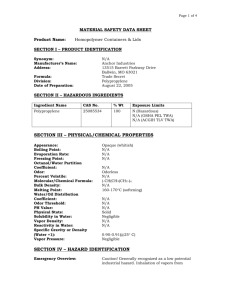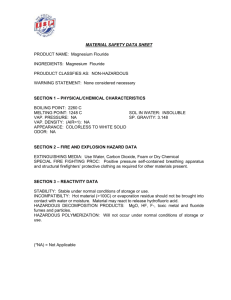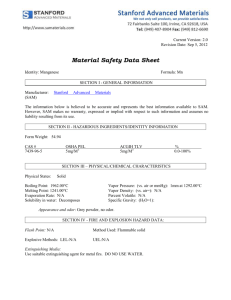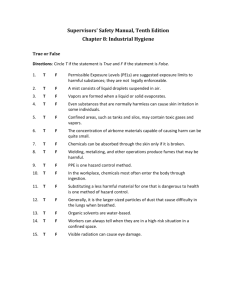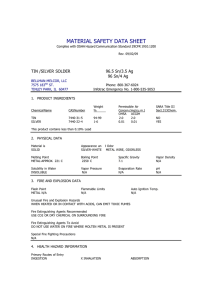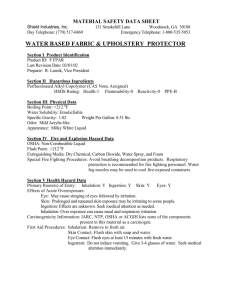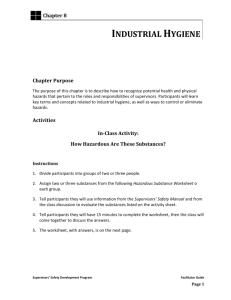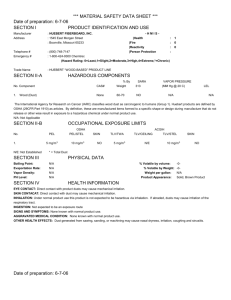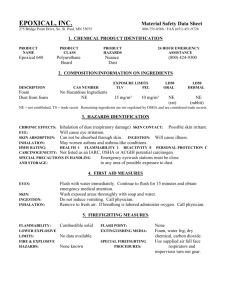Document - Chemat Scientific
advertisement
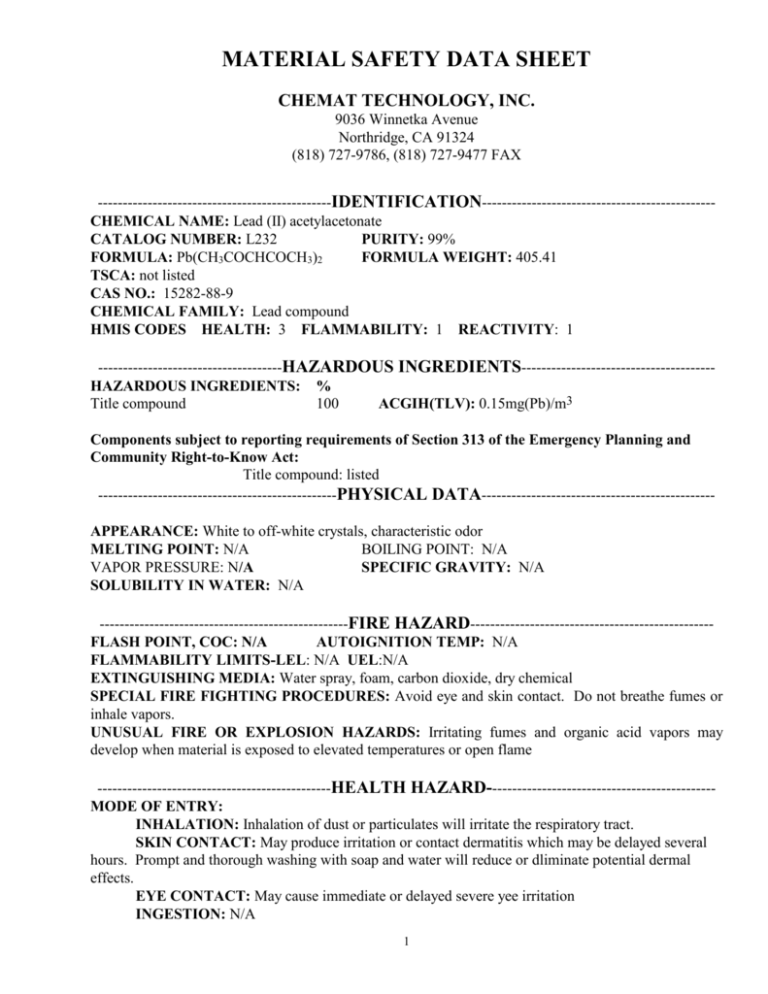
MATERIAL SAFETY DATA SHEET CHEMAT TECHNOLOGY, INC. 9036 Winnetka Avenue Northridge, CA 91324 (818) 727-9786, (818) 727-9477 FAX -----------------------------------------------IDENTIFICATION----------------------------------------------CHEMICAL NAME: Lead (II) acetylacetonate CATALOG NUMBER: L232 PURITY: 99% FORMULA: Pb(CH3COCHCOCH3)2 FORMULA WEIGHT: 405.41 TSCA: not listed CAS NO.: 15282-88-9 CHEMICAL FAMILY: Lead compound HMIS CODES HEALTH: 3 FLAMMABILITY: 1 REACTIVITY: 1 -------------------------------------HAZARDOUS INGREDIENTS--------------------------------------HAZARDOUS INGREDIENTS: % Title compound 100 ACGIH(TLV): 0.15mg(Pb)/m3 Components subject to reporting requirements of Section 313 of the Emergency Planning and Community Right-to-Know Act: Title compound: listed ------------------------------------------------PHYSICAL DATA----------------------------------------------APPEARANCE: White to off-white crystals, characteristic odor MELTING POINT: N/A BOILING POINT: N/A VAPOR PRESSURE: N/A SPECIFIC GRAVITY: N/A SOLUBILITY IN WATER: N/A --------------------------------------------------FIRE HAZARD------------------------------------------------FLASH POINT, COC: N/A AUTOIGNITION TEMP: N/A FLAMMABILITY LIMITS-LEL: N/A UEL:N/A EXTINGUISHING MEDIA: Water spray, foam, carbon dioxide, dry chemical SPECIAL FIRE FIGHTING PROCEDURES: Avoid eye and skin contact. Do not breathe fumes or inhale vapors. UNUSUAL FIRE OR EXPLOSION HAZARDS: Irritating fumes and organic acid vapors may develop when material is exposed to elevated temperatures or open flame -----------------------------------------------HEALTH HAZARD---------------------------------------------MODE OF ENTRY: INHALATION: Inhalation of dust or particulates will irritate the respiratory tract. SKIN CONTACT: May produce irritation or contact dermatitis which may be delayed several hours. Prompt and thorough washing with soap and water will reduce or dliminate potential dermal effects. EYE CONTACT: May cause immediate or delayed severe yee irritation INGESTION: N/A 1 CHRONIC TOXICITY: Exposure to dust or fumes of organic lead compounds is known to cause toxic effects. Lead is a cumulative poison. CARCINOGENCITY: NTP: No IARC: No OSHA: No EFFECTS OF OVEREXPOSURE: INHALATION: Lead is a cumulative poison. Whereas most ingested lead is eliminated by the body, inhaled lead compounds are absorbed by the respiratory tract and symptoms of lead poisoning may develop quickly. The most common type of lead poisoning is alimentary which is characterized by abnormal pain and discomfort. Other complaints are diarrhea, metallic taste, nausea, vomiting, headache and dizziness. EMERGENCY AND FIRST AID PROCEDURES: INHALATION: Move exposed individual to fresh air. Administer oxygen if needed. Call a physician.. SKIN CONTACT: Flush with water, then wash with soap and water EYE CONTACT: Immediately flush eyes, including under eyelids, with large amounts of water for at least 15 minutes. Call a physician. INGESTION: Never give fluids or induce vomitng if patient is unconscious or having convulsions. Get medical attention. Physician note: Diagnostic mobilization of lead with calcium EDTA may be useful in questionable cases. -----------------------------------------------REACTIVITY DATA-------------------------------------------STABILITY: Stable. CONDITIONS TO AVOID: Material decomposes slowly in contact with air by reaction with water and carbon dioxide. HAZARDOUS DECOMPOSITION PRODUCTS: Organic acid vapors and lead oxide fumes. HAZARDOUS POLYMERIZATION: None ---------------------------------ENVIRONMENTAL INFORMATION-------------------------------SPILL OR LEAKAGE PROCEDURES: May be hazardous to aquatic life if released to open waters. Sweep material and transfer to a suitable container for disposal. WASTE DISPOSAL: Dispose of as solid waste. Foloow all chemical pollution control regulations. ----------------------------------PROTECTION AND PRECAUTIONS-------------------------------VENTILATION REQUIREMENTS: Local exhaust. Mechanical is recommended. RESPIRATORY PROTECTION: If exposure exceeds TLV, NIOSH approved dust and mist respirator. EYE AND FACE PROTECTION: Chemical worker’s goggles. Do not wear contact lenses. OTHER CLOTHING AND EQUIPMENT: Rubber, neoprene or nitrile gloves. An eyewash and emergnecy shower should be available. Launder clothing before reuse. OTHER PRECAUTIONS: No special precautions necessary. To minimize exposure handle the material in an efficient fume hood. Store in sealed containers. --------------------------------------------------------------------------------------------------------------------------The information herein is believed to be accurate and reliable as of the date compiled. However, Chemat Technology, Inc. makes no representation, warranty or guarantee of any kind with respect to the information on this data sheet or any use of the product based upon this information. DATE PREPARED: June 1996 2

